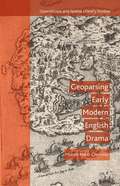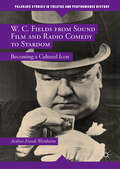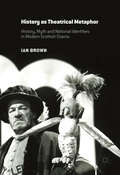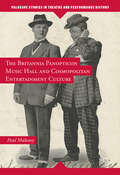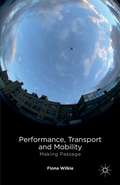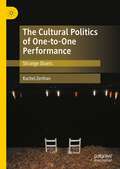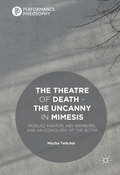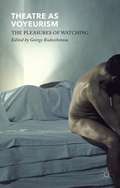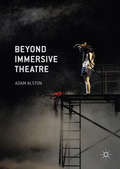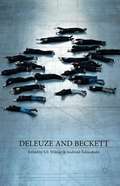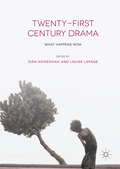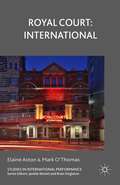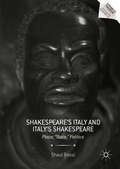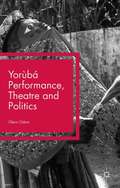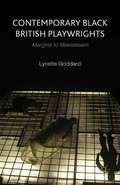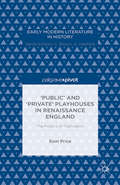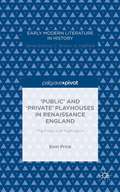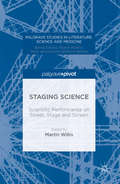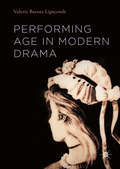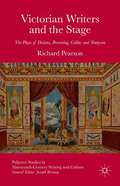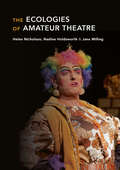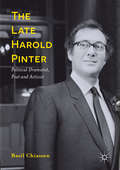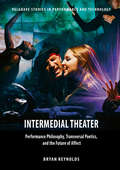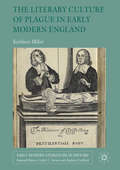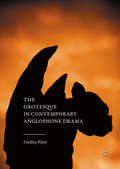- Table View
- List View
Geoparsing Early Modern English Drama
by Monica Matei-ChesnoiuGeo-spatial identity and early Modern European drama come together in this study of how cultural or political attachments are actively mediated through space. Matei-Chesnoiu traces the modulated representations of rivers, seas, mountains, and islands in sixteenth-century plays by Shakespeare, Jasper Fisher, Thomas May, and others.
W. C. Fields from Sound Film and Radio Comedy to Stardom: Becoming a Cultural Icon (Palgrave Studies in Theatre and Performance History)
by Arthur Frank WertheimW. C. Fields is known as a virtuoso comedian and legendary iconoclast who gave the gift of laughter to multitudes. As the first author to use the newly-opened Fields Papers at the Academy library, Arthur Frank Wertheim illuminates the comedian’s arduous ascent to stardom during Hollywood's golden age. The book reveals details of Fields’s turbulent private life, from his wife's refusal to divorce, to his estranged son, and to his fleeting relationships with women. Here is a portrait of an aggrieved artist whose emotional anguish found refuge in his poignant comedy about life’s frustrations and the human condition. This third volume in Wertheim's trilogy documents Fields's rise to iconic status during the counterculture 1960s, creating a legacy of his comedy for generations to come.
History as Theatrical Metaphor
by Ian BrownThis revelatory study explores how Scottish history plays, especially since the 1930s, raise issues of ideology, national identity, historiography, mythology, gender and especially Scottish language. Covering topics up to the end of World War Two, the book addresses the work of many key figures from the last century of Scottish theatre, including Robert McLellan and his contemporaries, and also Hector MacMillan, Stewart Conn, John McGrath, Donald Campbell, Bill Bryden, Sue Glover, Liz Lochhead, Jo Clifford, Peter Arnott, David Greig, Rona Munro and others often neglected or misunderstood. Setting these writers' achievements in the context of their Scottish and European predecessors, Ian Brown offers fresh insights into key aspects of Scottish theatre. As such, this represents the first study to offer an overarching view of historical representation on Scottish stages, exploring the nature of 'history' and 'myth' and relating these afresh to how dramatists use - and subvert - them. Engaging and accessible, this innovative book will attract scholars and students interested in history, ideology, mythology, theatre politics and explorations of national and gender identity.
The Britannia Panopticon Music Hall and Cosmopolitan Entertainment Culture
by Paul MaloneyFocusing on Glasgow's earliest surviving music hall, the Britannia, later the Panopticon, this book explores the role of one of the city's most iconic cultural venues within the cosmopolitan entertainment market that emerged in British cities in the nineteenth century. Shedding light on the increasing diversity of commercial entertainment provided by such venues - offering everything from music hall, early cinema and amateur nights to waxworks, menageries and freak shows - this study also encompasses the model of community-based, working-class music hall which characterised the Panopticon's later years, challenging narratives of the primacy of city centre variety. Providing a comprehensive analysis of this dynamic popular theatre of the industrial age, Maloney examines the role of the hall's managers, marketing and promotional strategies, audiences, and performing genres from the hall's opening in 1859 until final closure in 1938. The book also explores stage representations of Irish and Jewish immigrant communities present in surrounding city centre areas, demonstrating the Britannia's diasporic links to other British cities and centres in North America, thus providing a multifaceted and pioneering account of this still extant Victorian music hall.
Performance, Transport and Mobility: Making Passage
by F. WilkiePerformance, Transport and Mobility is an investigation into how performance moves, how it engages with ideas about movement, and how it potentially shapes our experiences of movement. Using a critical framework drawn from the 'mobility turn' in the social sciences, it analyses a range of performances that explore what it means to be in transit.
The Cultural Politics of One-to-One Performance: Strange Duets
by Rachel ZerihanThis monograph is the first study to critically examine works of performance made for an audience of one. Despite being a prolific feature of the performance scene since the turn of the millennium, critical writing about this area of contemporary practice remains scarce. This book proposes a genealogy of the curious relationship between solo performer and lone spectator through lineages in the histories of live art, visual art and theatre practices. Drawing on one-to-one performances by artists including Marilyn Arsem, Oreet Ashery, Franko B, Rosana Cade, Jess Dobkin, Karen Finley, David Hoyle, Adrian Howells, Kira O’Reilly, Barbara T Smith and Julie Tolentino, Rachel Zerihan produces research that is both affective and critical. This performance analysis proposes four frameworks through which to examine the significance and challenge of this work: cathartic, social, explicit and economic. One-to-one performance is proposed as a rich portal for examining the cultural politics of contemporary society. The book will appeal to students and scholars from performance studies, theatre, visual art and cultural studies.
The Theatre of Death – The Uncanny in Mimesis
by Mischa TwitchinThis book is concerned with such questions asthe following: What is the life of the past in the present? How might "thetheatre of death" and "the uncanny in mimesis" allow us to conceive of theafterlife of a supposedly ephemeral art practice? How might a theatricaliconology engage with such fundamental social relations as those between theliving and the dead? Distinct from the dominant expectation that actors shouldappear life-like onstage, why is it that some theatre artists - from Craig toCastellucci - have conceived of the actor in the image of the dead? This bookexplores such questions through the implications of the twofold analogyproposed in its very title: as theatre is to the uncanny, so death is tomimesis; and as theatre is to mimesis, so death is to the uncanny. Walter Benjamin once observed that: "The point at issuein the theatre today can be more accurately defined in relation to the stagethan to the play. It concerns the filling-in of the orchestra pit. The abysswhich separates the actors from the audience like the dead from the living. . . " Ifthe relation between the living and the dead can be thought of in terms of ananalogy with ancient theatre, what about modernity?
Theatre as Voyeurism
by George RodosthenousTheatre as Voyeurism usefully (re)defines the notion of voyeurism as an 'exchange' between performers and audience members in contemporary theatre and performance. Pleasure (erotic and/or aesthetic) is here privileged as a crucial factor in the way meaning is produced in the encounter with a theatrical work. George Rodosthenous has drawn together an intriguing selection of authors and the ten chapters make a significant contribution to the overarching critical project of assessing the value of approaching theatre through – and as – voyeurism. The authors focus on a range of case studies including specific theatre artists such as Jan Fabre, Romeo Castellucci, Ann Liv Young, Olivier Dubois and Punchdrunk. This edited volume is therefore relevant to prospective readers interested in various aspects of visual experience in the theatre today.
Beyond Immersive Theatre: Aesthetics, Politics and Productive Participation
by Adam AlstonImmersive theatre currently enjoys ubiquity, popularity and recognition in theatre journalism and scholarship. However, the politics of immersive theatre aesthetics still lacks a substantial critique. Does immersive theatre model a particular kind of politics, or a particular kind of audience? What's involved in the production and consumption of immersive theatre aesthetics? Is a productive audience always an empowered audience? And do the terms of an audience's empowerment stand up to political scrutiny? Beyond Immersive Theatre contextualises these questions by tracing the evolution of neoliberal politics and the experience economy over the past four decades. Through detailed critical analyses of work by Ray Lee, Lundahl & Seitl, Punchdrunk, shunt, Theatre Delicatessen and Half Cut, Adam Alston argues that there is a tacit politics to immersive theatre aesthetics - a tacit politics that is illuminated by neoliberalism, and that is ripe to be challenged by the evolution and diversification of immersive theatre.
Deleuze and Beckett
by S. E. Wilmer Audronė ŽukauskaitėDeleuze and Beckett is a collection of essays illuminating similarities between the philosophies and practices of Deleuze and Beckett. The contributors include some of the leading Beckett and Deleuze specialists in the world, and their essays address different ideas and concepts of Deleuzian philosophy as well as a wide range of Beckett's oeuvre, including his novels, short stories, stage and television plays, and film work. The book considers Deleuze's interpretation of Beckett's work anddemonstrates that Deleuzian concepts and ideas can be usefully applied to Beckett's texts in order provide a greater understanding of Beckett's characters and their journeys. Deleuze's philosophy helps us to recognize that what has been seen as the private territory of despair, loneliness, and emptiness in Beckett's work masks a world of flow and fluctuation that expresses multiple and heterogeneous possibilities.
Twenty-First Century Drama
by Louise Lepage Siân AdiseshiahWithin this landmark collection, originalvoices from the field of drama provide rich analysis of a selection of the mostexciting and remarkable plays and productions of the twenty-first century. But what makes the drama of the new millenium so distinctive? Which events, themes, shifts, and paradigms are marking its stages? Kaleidoscopic in scope, Twenty-FirstCentury Drama: What Happens Now creates a broad, rigorously criticalframework for approaching the drama of this period, including its forms,playwrights, companies, institutions, collaborative projects, and directors. The collection has a deliberately British bent,examiningestablished playwrights - such as Churchill, Brenton, and Hare - alongside anew generation of writers - including Stephens, Prebble, Kirkwood, Bartlett,and Kelly. Simultaneously international in scope, it engages with significant new work from the US,Japan, India, Australia, and the Netherlands, to reflect atwenty-first century context that is fundamentally globalized. The volume'scentral themes - the financial crisis, austerity, climate change, new forms ofhuman being, migration, class, race and gender, cultural politics and issues ofnationhood - are mediated through fresh, cutting-edge perspectives.
Royal Court: International (Studies in International Performance)
by E. Aston Mark O'ThomasThe first ever full-length study of the Royal Court Theatre's International Department, covering the theatre's unique programming of international plays and seasons, its London-based residences for writers from overseas, and the legacies of workshops conducted in more than 30 countries.
Shakespeare's Italy and Italy's Shakespeare
by Shaul BassiShaul Bassi is AssociateProfessor of English and Postcolonial Literature at Ca'Foscari University ofVenice, Italy. His publications include Visionsof Venice in Shakespeare, with Laura Tosi, and Experiences of Freedom in Postcolonial Literatures and Cultures, with Annalisa Oboe.
Yorùbá Performance, Theatre and Politics
by Glenn OdomThis book explains the connections between traditional performance (e.g. masked dances, prophecy, praise recitations), contemporary theatre (Wole Soyinka, Ola Rotimi, Tess Onwueme, Femi Osofisan, and Stella Oyedepo) , and the political sphere in the context of the Yorùbá people in Nigeria.
Contemporary Black British Playwrights: Margins to Mainstream
by L. GoddardThis book examines the socio-political and theatrical conditions that heralded the shift from the margins to the mainstream for black British Writers, through analysis of the social issues portrayed in plays by Kwame Kwei-Armah, debbie tucker green, Roy Williams, and Bola Agbaje.
‘Public’ and ‘Private’ Playhouses in Renaissance England: The Politics of Publication (Early Modern Literature in History)
by Eoin PriceAt the start of the seventeenth century a distinction emerged between 'public', outdoor, amphitheatre playhouses and 'private', indoor, hall venues. This book is the first sustained attempt to ask: why? Theatre historians have long acknowledged these terms, but have failed to attest to their variety and complexity. Assessing a range of evidence, from the start of the Elizabethan period to the beginning of the Restoration, the book overturns received scholarly wisdom to reach new insights into the politics of theatre culture and playbook publication. Standard accounts of the 'public' and 'private' theatres have either ignored the terms, or offered insubstantial explanations for their use. This book opens up the rich range of meanings made available by these vitally important terms and offers a fresh perspective on the way dramatists, theatre owners, booksellers, and legislators, conceived the playhouses of Renaissance London.
‘Public’ and ‘Private’ Playhouses in Renaissance England: The Politics of Publication (Early Modern Literature in History)
by Eoin Price‘Public’ and ‘Private’ Playhouses in Renaissance England.
Staging Science: Scientific Performance on Street, Stage and Screen (Palgrave Studies in Literature, Science and Medicine)
by Martin WillisThis book considers scientific performances across two centuries, from the early nineteenth century to the present day. Performances include demonstrations of technologies, experiments that look like theatre, theatre that looks like science, tourist representations and natural history film-making. Its key aim is to open debate on how scientific activity, both historical and contemporary, might be understood in the context of performance studies and the imaginative acts required to stage engaging performances.Scientific performances have become increasingly of interest to historians of science, literature and science scholars, and in the field of science studies. As yet, however, no work has sought to examine a range of scientific performances with the aim of interrogating and illuminating the kinds of critical and theoretical practices that might be employed to engage with them. With scientific performance likely to become ever more central to scholarly study in the next few years this volume offer a timely, and early, intervention in the existing debates, and aims, too, to be a touchstone for future work.
Performing Age in Modern Drama
by Valerie Barnes Barnes LipscombThis book is the first to examine age across the modern and contemporary dramatic canon, from Arthur Miller and Tennessee Williams to Paula Vogel and Doug Wright. All ages across the life course are interpreted as performance and performative both on page and on stage, including professional productions and senior-theatre groups. The common admonition "act your age" provides the springboard for this study, which rests on the premise that age is performative in nature, and that issues of age and performance crystallize in the theatre. Dramatic conventions include characters who change ages from one moment to the next, overtly demonstrating on stage the reiterated actions that create a performative illusion of stable age. Moreover, directors regularly cast actors in these plays against their chronological ages. Lipscomb contends that while the plays reflect varying attitudes toward performing age, as a whole they reveal a longing for an ageless self, a desire to present a consistent, unified identity. The works mirror prevailing social perceptions of the aging process as well as the tension between chronological age, physiological age, and cultural constructions of age.
Victorian Writers and the Stage
by Richard PearsonThis book comprises a study of the plays of Dickens, Browning, Wilkie Collins and Tennyson, alongside the fiction and periodical writings of Thackeray and others. These major Victorian writers authored several professional plays, but why has their achievement been overlooked? Victorian Writers and the Stage brings together comprehensively, for the first time, the professionally performed plays of a group of well-known authors – some of which plays enjoyed long and successful seasons,but all of which have been largely forgotten. The author examines the goal of these writers to become part of an expanding theatrical industry and the problems they encountered in risking their reputations on a literature felt by many to be vulgar and illegitimate. A wealth of new detail carefully positions the plays within the context of the changing Victorian theatre industry and the great battle between the Major and Minor theatres for the future of the modern stage.
The Ecologies of Amateur Theatre
by Jane Milling Nadine Holdsworth Helen NicholsonThis book is the first major study of amateur theatre, offering new perspectives on its place in the cultural and social life of communities. Historically informed, it traces how amateur theatre has impacted national repertoires, contributed to diverse creative economies, and responded to changing patterns of labour. Based on extensive archival and ethnographic research, it traces the importance of amateur theatre to crafting places and the ways in which it sustains the creativity of amateur theatre over a lifetime. It asks: how does amateur theatre-making contribute to the twenty-first century amateur turn?
The Late Harold Pinter
by Basil ChiassonThis volume is the first to provide a book-length study of Pinter's overtly political activity. With chapters on political drama, poetry, and speeches, it charts a consistent tension between aesthetics and politics through Pinter's later career and defines the politics of the work in terms of a pronounced sensory dimension and capacity to affect audiences. The book brings to light unpublished letters and drafts from the Pinter Archive in the British Library and draws his political poems and speeches, which have previously been overshadowed by his plays, into the foreground. Intended for students, instructors, and researchers in drama and theatre, performance studies, literature, and media studies, this book celebrates Pinter's later life and work by discerning a coherent political voice and project and by registering the complex ways that project troubles the divide between aesthetics and politics.
Intermedial Theater
by Bryan ReynoldsThis book explores relationships between intermedial theater, consciousness, memory, objects, subjectivity, and affect through productive engagement with the performance aesthetics, socio-cognitive theory, and critical methodology of transversal poetics alongside other leading philosophical approaches to performance. It offers the first sustained analysis of the work of Gilles Deleuze, F#65533;lix Guattari, Jean Baudrillard, and Friedrich Nietzsche in relation to the contemporary European theater of Jan Lauwers and Needcompany, Romeo Castellucci and Soc#65533;etas Raffaello Sanzio, Thomas Ostermeier, Rodrigo Garc#65533;a and La Carnicer#65533;a Teatro, and the Transversal Theater Company. It connects contemporary uses of objects, simulacra, and technologies in both posthumanist discourse and postdramatic theater to the transhistorically and culturally mediating power of Shakespeare as a means by which to discuss the affective impact of intermedial theater on today's audiences.
The Literary Culture of Plague in Early Modern England
by Kathleen MillerThis book is about the literary culture that emerged during and in the aftermath of the Great Plague of London (1665). Textual transmission impacted upon and simultaneously was impacted by the events of the plague. This book examines the role of print and manuscript cultures on representations of the disease through micro-histories and case studies of writing from that time, interpreting the place of these media and the construction of authorship during the outbreak. The macabre history of plague in early modern England largely ended with the Great Plague of London, and the miscellany of plague writings that responded to the epidemic forms the subject of this book.
The Grotesque in Contemporary Anglophone Drama
by Ondřej PilnýGrotesque features have been among the chief characteristics of drama in English since the 1990s. This new book examines the varieties of the grotesque in the work of some of the most original playwrights of the last three decades (including Enda Walsh, Philip Ridley, Tim Crouch and Suzan-Lori Parks), focusing in particular on ethical and political issues that arise from the use of the grotesque.
